No one told me this was Australia’s scariest tourist attraction! Climbing a 75 m fire lookout tree seemed like a good idea at the time… age 66 and in my prime.
Karri trees can grow up to 90 m (295 ft) and are among the tallest trees in the world and the highest trees tourists can climb anywhere. In Western Australia, there are two giant fire lookout trees that visitors can climb, both located near Pemberton in the old-growth Karri forest.
Join me as I clamber up the tallest lookout tree in the world, the 75 m high Dave Evans Bicentennial Tree in Warren National Park. The viewing platform on the Bicentennial tree, at 60m, is about the same height as the top of the Sydney Opera House.
How can you climb a 75 m high tree without using ropes or wearing a harness? By using spikes! No, not on your feet…in the tree. 165 giant spikes have been driven into each tree at regular intervals to form a spiral ladder. Wire-netting has been added all the way up to enclose the spiral, and I can tell you from personal experience that it is a welcome safety feature.
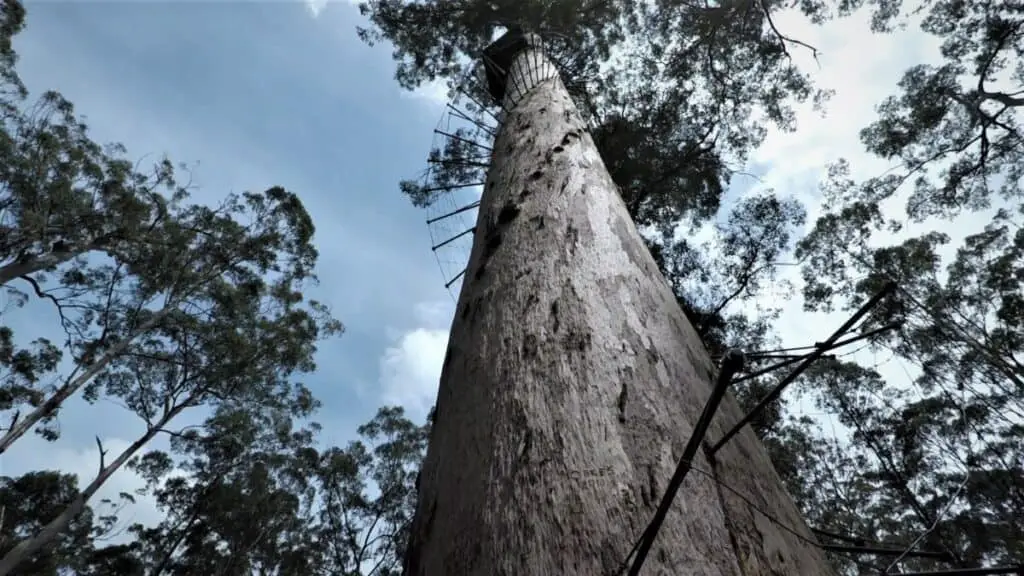
As a visitor from Canada it struck me that there is no way you would be allowed to climb a tree like this in North America, given liability issues and the degree of risk. Apparently only 20% of climbers make it to the top. No one has died, but a couple of people have had heart attacks after the climb. My wife Jan was wise. She stayed at the bottom close to where I would land.

There were originally eight karri trees used as fire lookouts between 1937 and 1952. In the case of the Bicentennial tree I climbed, 165 spikes were driven into the tree in 1988 as part of Australia’s bicentennial celebrations. The 62 m Gloucester Tree, in Gloucester National Park, was turned into a lookout tree in 1947, with 153 spikes. Yes, the Duke of Gloucester was visiting Pemberton as the lookout was being built. Too bad it wasn’t Big Bird! (Big Bird Tree would have a nice ring to it.)
Both lookout trees offer spectacular views of the old-growth Karri forest.
The Climb
After the first 100 spikes I noticed my thighs were getting a bit sore. Looking at my face in the photo below you might discern a touch of nervousness. Not fear, mind you, just concern associated with my body telling me that I was doing something dangerous and stupid.
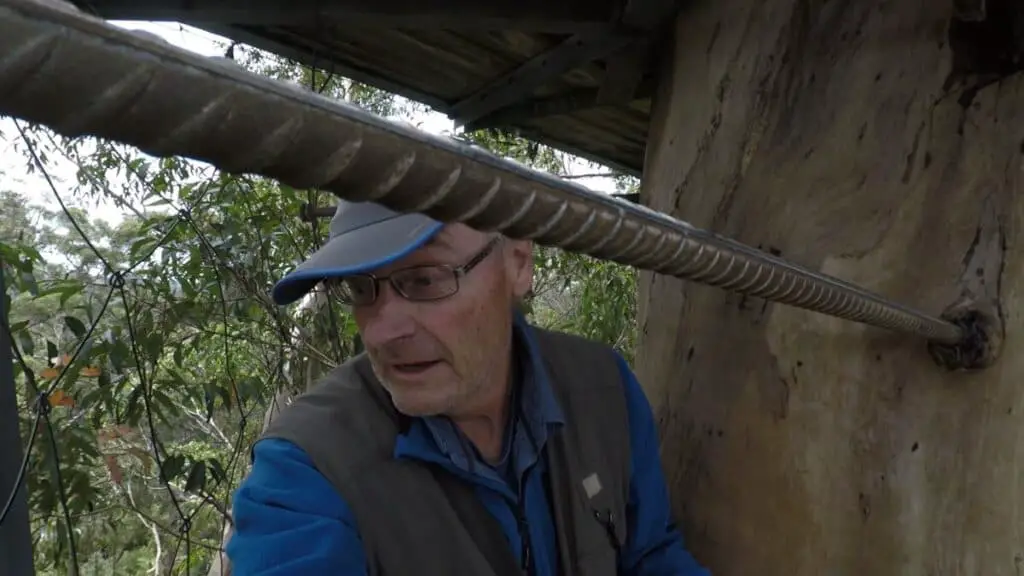
The spikes appear to be big and sturdy until you step on them. Then you realize that they are only about an inch in diameter and hard on the feet, especially for tourists wearing flip-flops. I was wearing sturdy hiking boots and the spikes still made an impression on my sole.
When you arrive at the first platform about half-way up, there’s a sign reminding you “THAT WAS THE EASY BIT!” The toughest part is still ahead. The spiral gets even steeper and narrower. Fortunately, I was alone on the spikes, I can’t imagine trying to squeeze past another person, especially at the narrow bits near the top.
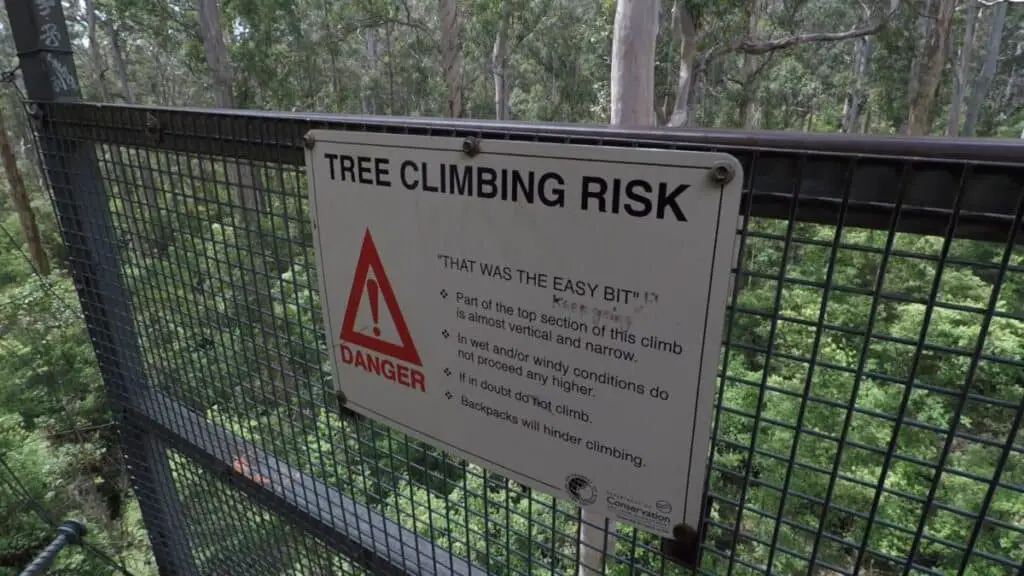
As I climbed higher and higher, my wife on the ground below became tinier and tinier. It started to really sink in that I was climbing as high as a 20-story building on skinny metal spikes. One of the most disconcerting aspects was the view down between my feet. The spike I was standing on seemed very insignificant and surrounded by a lot of nothing.
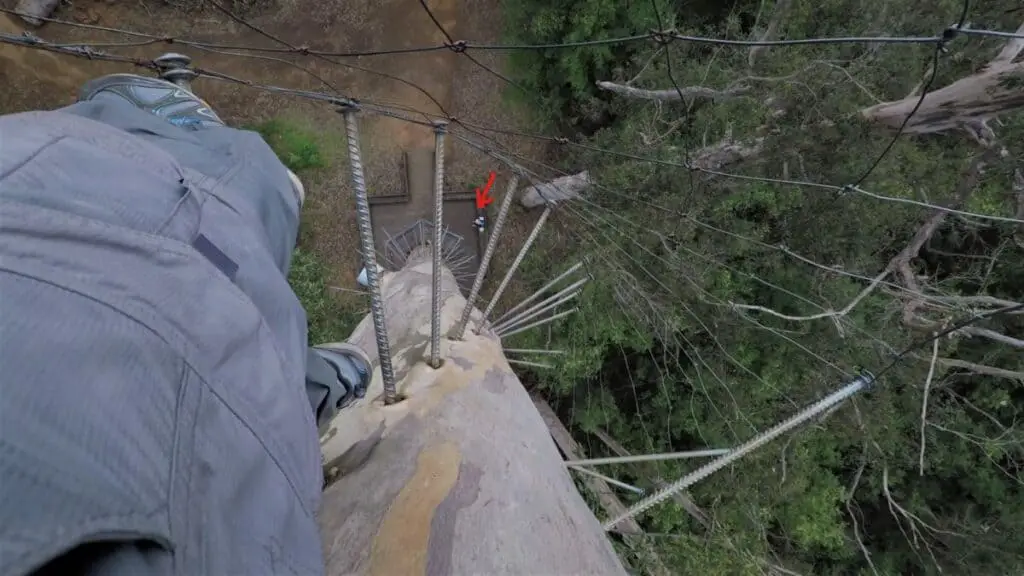
It struck me that one slip would be either very painful or potentially deadly. Slipping off a spike would mean landing hard in a straddled position and crushing my balls. This was the best-case scenario! If I didn’t straddle the spike, it would be a lot worse to ricochet off the spikes and wire-cage below, tearing my fingers on bark and metal trying to break my fall. I could envision broken bones, a cracked noggin, or no noggin at all!
That’s the worst part. Your mind starts to invent all sorts of scary scenarios. Better to stay focused, one spike at a time and not spend much time looking straight down.
By the time I had climbed 150 spikes I was getting tired. My thighs were aching because whoever drove the spikes into the tree spaced them for an 8-foot spider not a 6-foot geezer. Each step up was a big step and then came the next, and the next, and the next…
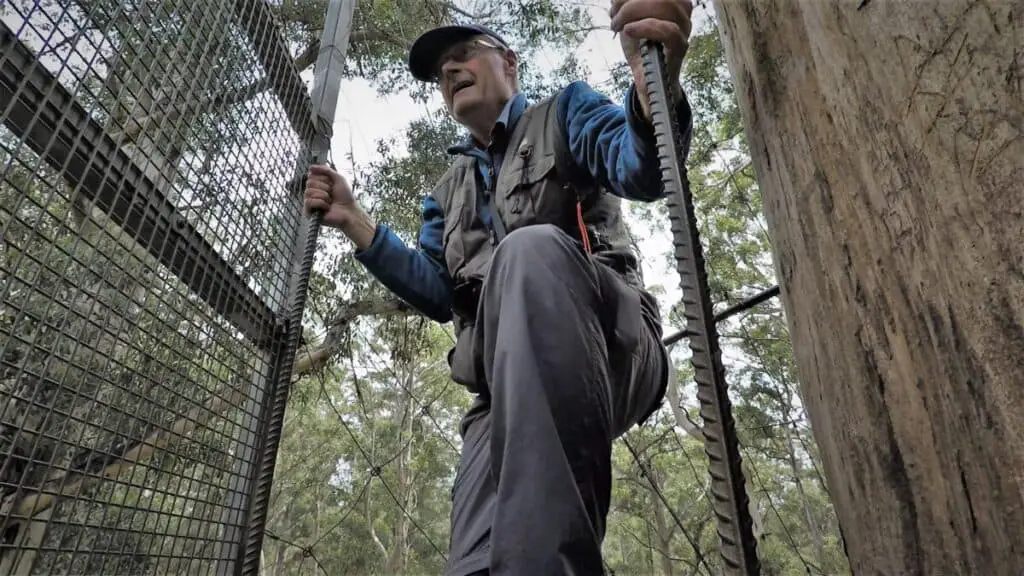
The view from the top platform was fantastic. I felt elated at my accomplishment and gazed all around to soak in the view of the old-growth Karri forest spread out below me. The beauty of the Bicentennial tree is that it is so tall that you stand above the rest of the forest canopy and witness the splendour of a sea of treetops below.
Watch me climb 200 feet in 3 minutes!
The Descent
As I looked down the long, long spiral straight below I realized I was only half-way there. Back to work, one step at a time! Thigh master here we come!

You get into a rhythm, but there’s no way to avoid looking down. If you don’t place the ball of your foot exactly right on the next skinny spike below…well, you know. You need to watch exactly where you step. The platform half-way down provides a good resting spot for weary thighs and sore soles.
As I neared the bottom, a couple of young ladies stood waiting for their turn. Luckily for me they waited since there’s not much room for passing on the spikes. I thought they looked rather sparsely dressed for the occasion, and both wore the inevitable flip-flops. They started climbing with trepidation and kept glancing down. After about 20 spikes they called a hasty meeting of the minds and made a good decision. That was far enough! I was glad to see them head back to earth.
Soon a group of three Aussie blokes arrived. They were enjoying a beautiful sunny day out with the lads and had fun taking photos around the spikes at the base of the tree. Flip-flops, of course.
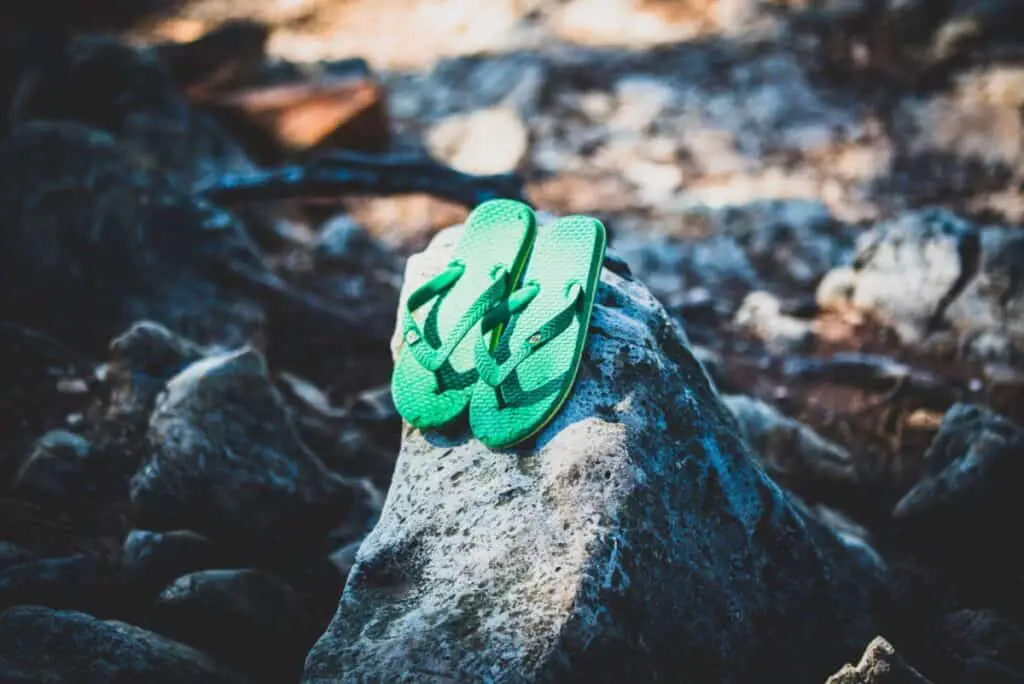
I’ll admit that Aussies have tough feet from spending so much time barefoot, but I don’t think it would be possible to climb to the top wearing flip-flops. The spikes are just too skinny, and a person’s entire body weight is focused on that one narrow pressure point with each step. I think that helps to explain the 20% that reach the top. They’re probably wearing boots or shoes.
These three blokes were laughing and joking, pushing and shoving, for the first 30 spikes. Then they slowed down as the fun began to wear thin. Like one-inch diameter thin! They had another good laugh and decided to head back down.
Seems like there’s a high-attrition rate for climbing the famed fire lookout trees of WA. Shame, really, so many people are missing out on reaching the top of Australia’s scariest tourist attraction!

Old-growth Karri forests
The biologically unique forests of Western Australia are separated from the forests of eastern Australia by several thousand miles of desert and scrub. They provide essential habitat for a wide range of endemic plants and wildlife species found nowhere else.

Karri (Eucalyptus diversicolor) is the tallest of the eucalypt species that grow only in Australia’s south-west corner and nowhere else in the world. The other giant eucalypts growing in this region are the jarrah, marri, and red tingle.
Karri can live 300-400 years or more and reach full height after only 75 years. The fire lookout trees are likely over 250 years old.
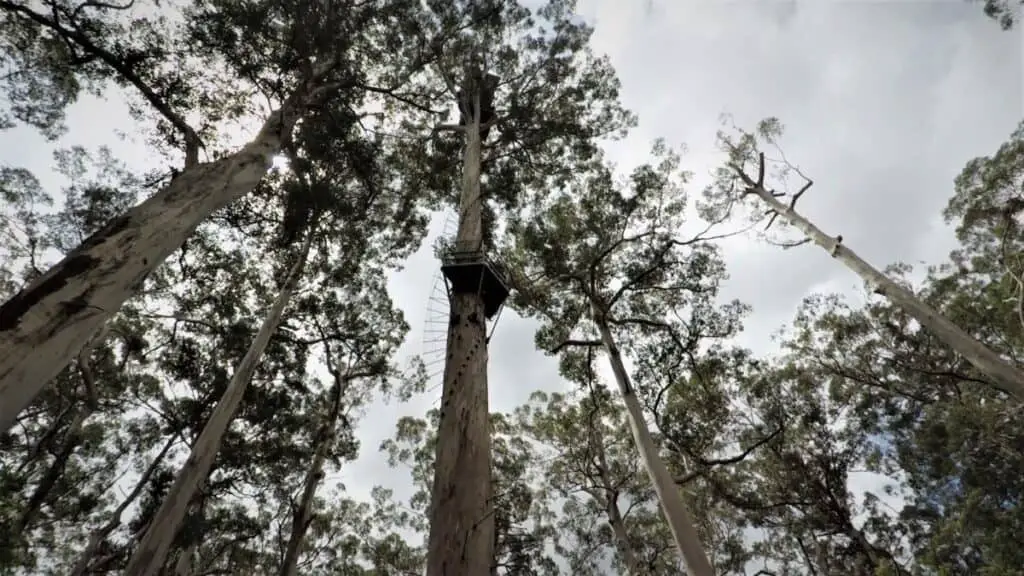
Karri has a long, straight trunk with smooth bark that it sheds each year. The outer bark changes color with age, with beautiful patchworks of pink, orange, grey and white. The trees produce white flowers in the spring, but only once every seven to 10 years. The nectar is highly sought after by birds, possums, and insects. The local Karri honey is considered heavenly in flavor.
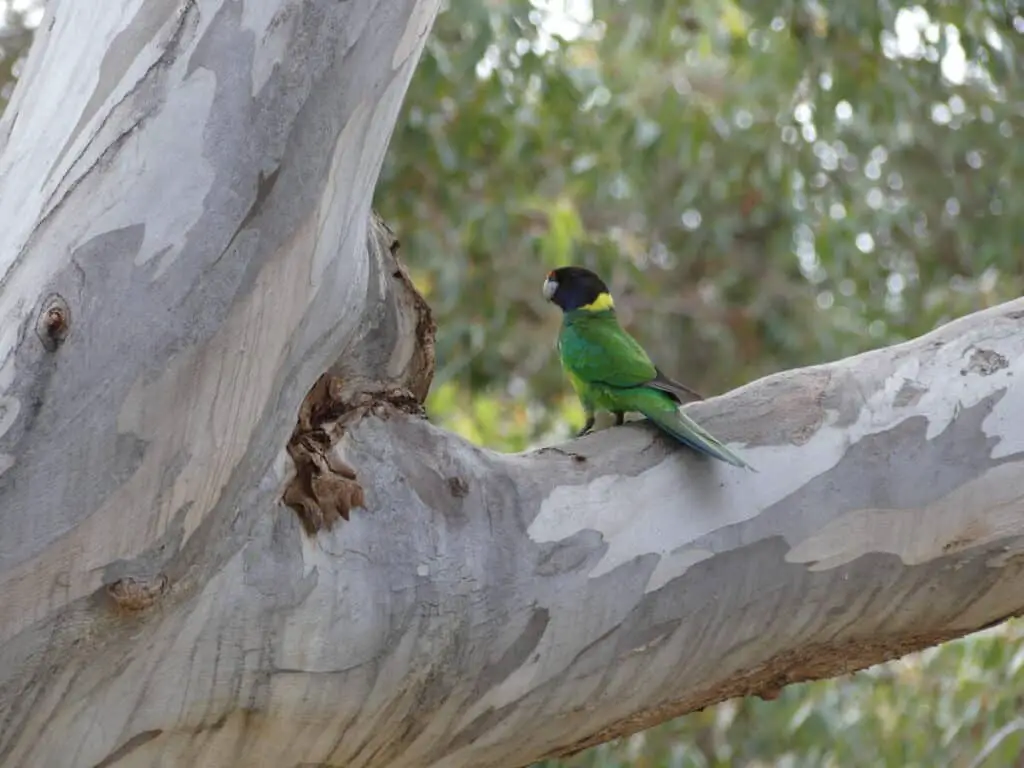
Karri is a prized hardwood species that has been logged extensively in past centuries. Before the arrival of Europeans, these forests covered about 3,600,000 hectares in the southwest of WA. Karri forests now cover less than 200,000 ha (490,000 acres).
How do you get to the fire lookout trees?
Go to Pemberton, Western Australia, and head to the visitor center.
The Pemberton Visitor Centre has information and maps for the climbing trees. They will even sell you a climbing certificate. Don’t forget your National Park Pass, required to enter the national parks where the trees are located. The centre is open 7 days a week from 9am to 5pm.
National Park camp sites
There are excellent camp sites in Warren National Park. We stayed at Draftys Camp right beside the Warren River. Draftys has two camping loops with 22 shady camp sites, toilets and a camp kitchen with picnic tables and free gas barbecues.
Resources
Western Australia Parks and Wildlife Service
Check out their excellent website for this area.

Karri Forest Explorer
Here’s an Karri forest explorer – this link opens the PDF file
Tree Top Walk
If you don’t feel like risking life and limb on Australia’s scariest tourist attraction, check out the Valley of Giants. You can take the Tree Top Walk suspended 40 metres high in the canopy of an ancient tingle forest.
Our Favorite Gear For Travel
We love to travel in search of exceptional wildlife viewing opportunities and for life-enhancing cultural experiences.
Here is the gear we love to travel with for recording our adventures in safety and comfort:
- Action Camera: GoPro Hero10 Black – we find these waterproof cameras are invaluable for capturing the essence of our adventures in video format. Still photos are great, but video sequences with all the sights and sounds add an extra dimension. I use short video clips to spice up many of my audiovisual presentations.
- Long Zoom Camera: Panasonic LUMIX FZ300 Long Zoom Digital Camera – I love this camera for its versatility. It goes from wide angle to 28X optical in a relatively compact design. On safari in Africa I’ve managed to get good shots of lions that the folks with long lenses kept missing – because the lions were too close! I also like the 120 fps slow-motion for action shots of birds flying and animals on the move. I call this my “bird camera.”
- 360 Camera: Insta360 ONE R 360 – 5.7K 360 Degree Camera, Stabilization, Waterproof – see my article How to Take Impossible Shots with Your 360 Camera. This camera is literally like taking your own camera crew with you when you travel! Read my article and you’ll see why.
- Backpack camera mount: Peak Design Capture Clip
- Drone: DJI Mini 2 (Fly More Combo) – this mini drone is made for travel!
- Water Filtration: LifeStraw Go Water Filter Bottle
- Binoculars: Vortex Binoculars or Vortex Optics Diamondback HD Binoculars (good price)
See Our TOP Articles for More Fascinating Creatures
- Do Woodpecker Tongues Wrap Around the Brain? (Action Video and Diagrams)
- Can Dead Jellyfish Sting? How Do Stinging Cells (Nematocysts) Work? Is Vinegar Effective?
- Are Birds Dinosaurs? Latest Science (How Birds Evolved from Dinosaurs)
- How do Snakes Mate? (Snake Reproduction Explained in Detail – with Videos and Diagrams)
- How do Octopus Reproduce? (Cannibalistic Sex, Detachable Penis)
- Do Jellyfish have Brains? How Can they Hunt without Brains?
- Why are Deep Sea Fish So Weird and Ugly? Warning: Scary Pictures!
- How do Electric Eels Shock Their Prey? Can an Electric Eel Kill You?
- Are Komodo Dragons Dangerous? Where Can you See Them?
- Koala Brains – Why Being Dumb Can Be Smart (Natural Selection)
- Why do Lions Have Manes? (Do Dark Manes Mean More Sex?)
- How Do Lions Communicate? (Why Do Lions Roar?)
- How Dangerous are Stonefish? Can You Die if You Step on One?
- What Do Animals Do When They Hibernate? How do they Survive?
- Leaf Cutter Ants – Surprising Facts and Adaptations; Pictures and Videos
- Irukandji Jellyfish Facts and Adaptations; Can They Kill You? Are they spreading?
- How to See MORE Wildlife in the Amazon: 10 Practical Tips
- Is it Safe to go on Safari with Africa’s Top Predators and Most Dangerous Animals?
- What to Do if You Encounter a Bullet Ant? World’s Most Painful Stinging Insect!
- How Do Anglerfish Mate? Endless Sex or Die Trying!
- How Smart are Crocodiles? Can They Cooperate, Communicate…Use Tools?
- How Can We Save Our Oceans? With Marine Sanctuaries!
- Why Are Male Birds More Colorful? Ins and Outs of Sexual Selection Made Easy!
- Why is the Cassowary the Most Dangerous Bird in the World? 10 Facts
- How Do African Elephants Create Their Own Habitat?
- What is Killing Our Resident Orcas? Endangered Killer Whales
- Why are Animals of the Galapagos Islands Unique?
- Where Can You See Wild Lemurs in Madagascar? One of the Best Places
- Where Can You see Lyrebirds in the Wild? the Blue Mountains, Australia
- Keeping Mason Bees as Pets
- Why do Flamingos have Bent Beaks and Feed Upside Down?
- Why are Hippos Dangerous? (Do They Attack People?)

